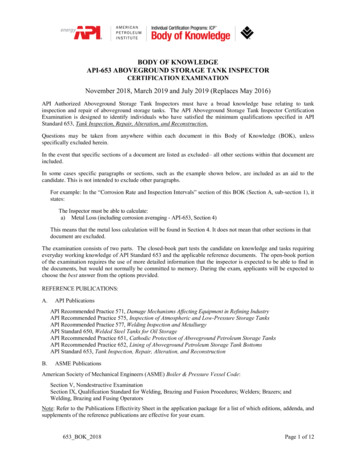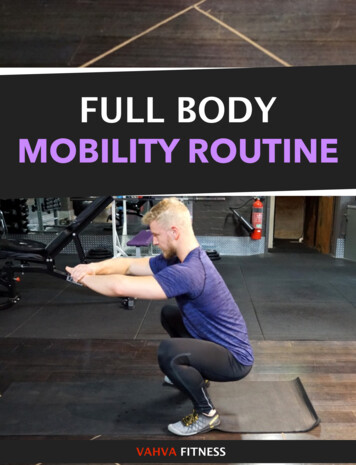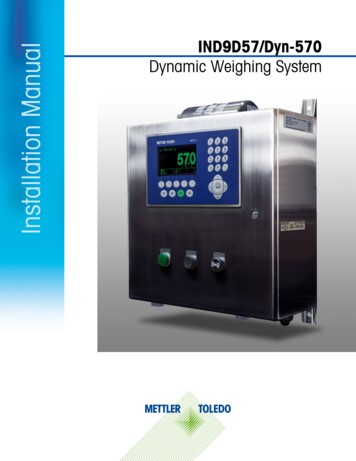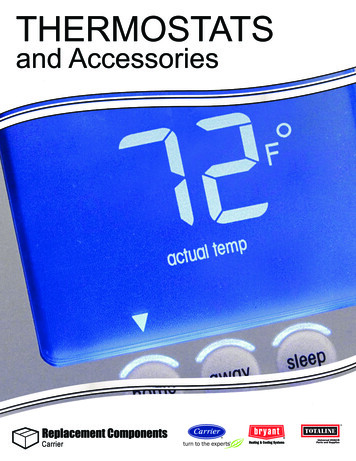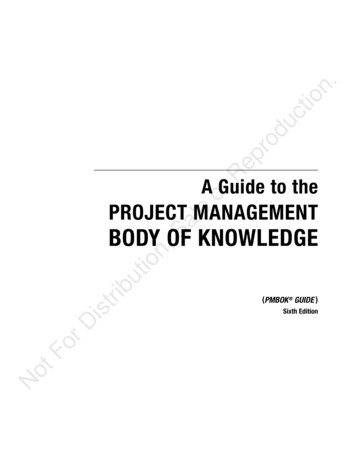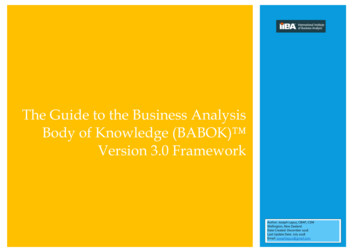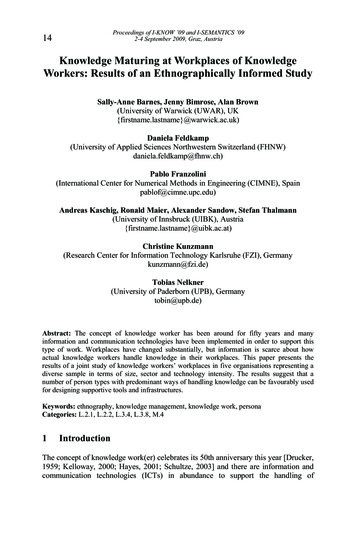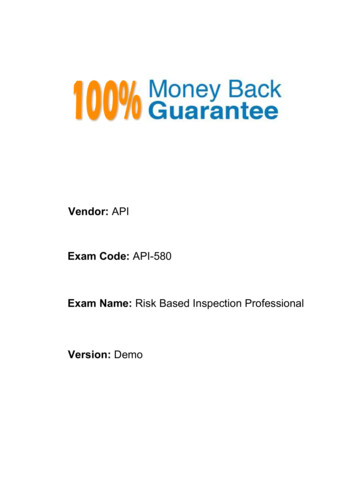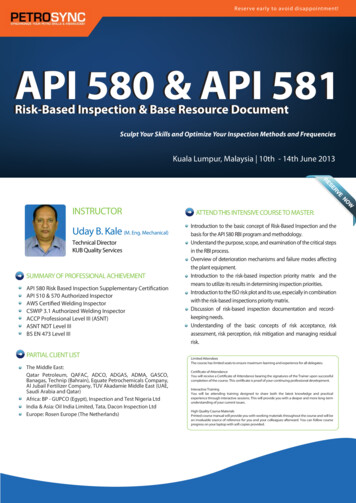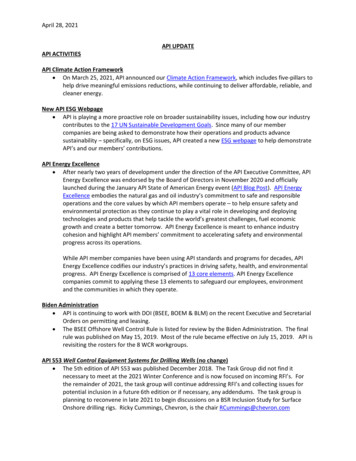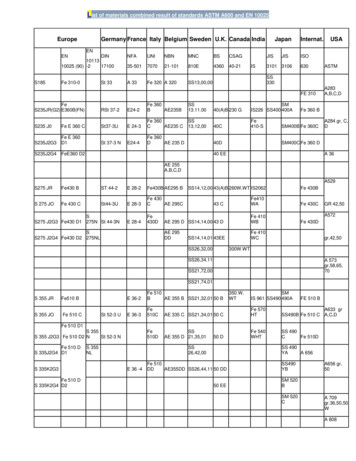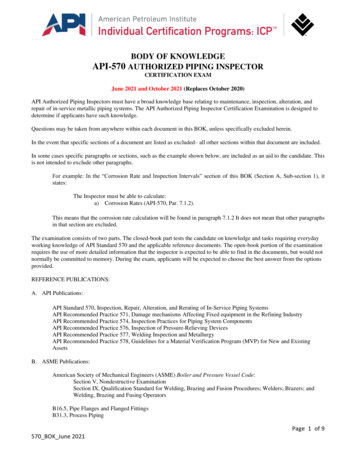
Transcription
BODY OF KNOWLEDGEAPI-570 AUTHORIZED PIPING INSPECTORCERTIFICATION EXAMJune 2021 and October 2021 (Replaces October 2020)API Authorized Piping Inspectors must have a broad knowledge base relating to maintenance, inspection, alteration, andrepair of in-service metallic piping systems. The API Authorized Piping Inspector Certification Examination is designed todetermine if applicants have such knowledge.Questions may be taken from anywhere within each document in this BOK, unless specifically excluded herein.In the event that specific sections of a document are listed as excluded– all other sections within that document are included.In some cases specific paragraphs or sections, such as the example shown below, are included as an aid to the candidate. Thisis not intended to exclude other paragraphs.For example: In the “Corrosion Rate and Inspection Intervals” section of this BOK (Section A, Sub-section 1), itstates:The Inspector must be able to calculate:a) Corrosion Rates (API-570, Par. 7.1.2).This means that the corrosion rate calculation will be found in paragraph 7.1.2 It does not mean that other paragraphsin that section are excluded.The examination consists of two parts. The closed-book part tests the candidate on knowledge and tasks requiring everydayworking knowledge of API Standard 570 and the applicable reference documents. The open-book portion of the examinationrequires the use of more detailed information that the inspector is expected to be able to find in the documents, but would notnormally be committed to memory. During the exam, applicants will be expected to choose the best answer from the optionsprovided.REFERENCE PUBLICATIONS:A. API Publications:API Standard 570, Inspection, Repair, Alteration, and Rerating of In-Service Piping SystemsAPI Recommended Practice 571, Damage mechanisms Affecting Fixed equipment in the Refining IndustryAPI Recommended Practice 574, Inspection Practices for Piping System ComponentsAPI Recommended Practice 576, Inspection of Pressure-Relieving DevicesAPI Recommended Practice 577, Welding Inspection and MetallurgyAPI Recommended Practice 578, Guidelines for a Material Verification Program (MVP) for New and ExistingAssetsB. ASME Publications:American Society of Mechanical Engineers (ASME) Boiler and Pressure Vessel Code:Section V, Nondestructive ExaminationSection IX, Qualification Standard for Welding, Brazing and Fusion Procedures; Welders; Brazers; andWelding, Brazing and Fusing OperatorsB16.5, Pipe Flanges and Flanged FittingsB31.3, Process PipingPage 1 of 9570 BOK June 2021
Note: Refer to the Publications Effectivity Sheet in the application package for a list of specific editions, addenda, andsupplements of the referenced publications that are effective for your examination date.The following is the list of specific topics in which an API certified Piping Inspector should be knowledgeable.CALCULATIONS FOR EVALUATING THICKNESS MEASUREMENTS, INSPECTION INTERVALS,AND PIPING INTEGRITYA. Code calculation questions will be oriented toward existing in-service piping, not new piping. API AuthorizedPiping Inspectors should be able to check and perform calculations relative to in-service deterioration, repairs,rerates, or alterations, such as those included in the following eight categories.Note: Candidates are expected to understand the US customary units (inches, feet, PSI, etc.) and the SI units (metricsystem) and to use both system formulas.1.CORROSION RATES AND INSPECTION INTERVALSThe Inspector should be able to understand inspection data and determine the thickness measurement and visual externalinspection intervals.The Inspector must be able to calculate:a) Corrosion Rates (API-570, Par. 7.1.2)b) Remaining Service Life (API-570, Par., 7.2)c) Inspection Interval (API-570, Par., 6.3.3 & Table 2)The formulas for performing the above calculations and rules for setting the inspection intervals may be "closed-book”during the exam.2.WELD JOINT QUALITY FACTORS AND CASTING QUALITY FACTORSThe inspector should be able to determine the weld joint quality factor “Ej” of a longitudinal pipe weld joint. Theinspector should be able to determine:a) Casting Quality factor, Ec from B31.3, 302.3.3 (b) and Table A-1Ab) Weld Joint Quality factors from ASME B31.3, 302.3.4 and Table A-1B;c) Increased Joint Quality Factors by performing supplemental NDE from ASME B31.3 Table 302.3.4;Determining weld joint quality factor may be part of an internal pressure problem since the joint factor Ej is used in theformulas for determining required thickness or internal design pressure.3.INTERNAL PRESSURE / MINIMUM THICKNESS OF PIPEThe inspector should be able to determine:a)The minimum required thickness or pressure design thickness of a straight pipe section for internal pressureonly (ASME B31.3 Section 304.1.1 and 304.1.2);b) The minimum required thickness of a permanent blank for a given design pressure (ASME B31.3 Section304.5.3);c) The "MAWP" of corroded pipe, compensating for expected corrosion loss at the next inspection (API 570, Par.,7.5)The inspector should also be able to compensate for the corrosion allowance. (Add or subtract based on requirementsfrom the exam problem).Page 2 of 9570 BOK June 2021
4.PRESSURE TESTINGThe inspector should be able to:a) Demonstrate knowledge concerning hydrostatic leak testing (ASME B31.3 Section 345.4)b) Demonstrate knowledge concerning pneumatic leak testing (ASME B31.3 Section 345.5)c) Calculate a hydrostatic or pneumatic leak test pressure (ASME B31.3 Sections 345.4, 345.5)5.IMPACT TESTINGThe inspector should be able to:a)Determine the minimum metal temperature of a material, which is exempt from impact testing (ASME B31.3,Section 323.2.2, Figure 323.2.2A & Table A-1).b) Determine the minimum required Charpy V-notch impact values of a given material. (ASME B31.3, Section323.3, Table 323.3.5)6.PREHEATING AND HEAT TREATMENT REQUIREMENTSThe inspector should be able to determine which weld sizes require preheating and/or heat treatment. The inspector alsoshould be able to determine what is the required or recommended preheat temperature (ASME B31.3, Section 330 &Table 330.1.1).7.THERMAL EXPANSIONThe inspector should be able to determine the total thermal expansion of a material between temperatures (ASME B31.3,Appendix C, Table C-1).8.MINIMUM WALL THICKNESS & WORKING PRESSURES FOR FLANGESThe inspector should be able to determine the minimum wall thickness and working pressure requirements for flanges.The inspector should also be able to:a)Determine the working pressure and minimum/maximum system hydrostatic test pressure for a flange ofspecified material and temperature (ASME B16.5, Par. 2. & Table 1A & Tables 2-1.1 through 2-3. 19 andTables II-2.1.1 through II-2-3.19).b) Determine the minimum dimensions of a given flange (ASME B16.5 Tables 7 through 22 and Tables II7through 22).c) Determine maximum working pressure of a flange when given the design temperature, flange material andflange class.d) Determine maximum temperature of a flange when given the design pressure, flange material and flange class.e) Determine most cost effective flange when given the design pressure, design temperature, and flange material.9.MINIMUM REQUIRED THICKNESS OF A PERMANENT BLANK (ASME B31.3, Par. 304.5.3)Page 3 of 9570 BOK June 2021
B. The following are the ASME B31.3 code engineering requirements that are excluded from the examination and thatthe API Authorized Piping Inspectors will NOT be expected to know for the purposes of certification 18.19.20.21.22.23.24.25.26.27.28.29.30.302- Design criteria – (All except for 302.3.3 Casting Quality Factor, Ec, and 302.3.4, Weld Joint Quality Factor,Ej)304.1.3- Straight Pipe Under External Pressure304.2- Curved and Mitered Segments of Pipe304.3- Branch Connections304.4- Closures304.5- Pressure Design of Flanges & Blanks (All except 304.5.3, Blanks)304.6- Reducers304.7- Pressure Design of Other Components315- Tubing Joints316- Caulked Joints317- Soldered and Brazed Joints318- Special Joints319.4- Flexibility Analysis319.5- Reactions319.6- Calculation of Movements319.7- Means of Increasing Flexibility322.3- Instrument PipingChap.VII- Nonmetallic Piping and Piping Lined With NonmetalsChap.VIII- Piping for Category M Fluid ServiceChap.IX- High Pressure PipingApp.B- Stress Tables and Allowable Pressure Tables for NonmetalsApp.D- Flexibility and Stress Intensification FactorsApp.E- Reference StandardsApp.G- SafeguardingApp.H- Sample Calculations for Branch ReinforcementApp.J- NomenclatureApp.K- Allowable Stresses for High Pressure PipingApp R - Use of Alternative Ultrasonic Acceptance CriteriaApp.X- Metallic Bellows Expansion JointsApp.Z- Preparation of Technical InquiriesPage 4 of 9570 BOK June 2021
II. WELDING PROCEDURE AND QUALIFICATION EVALUATIONA. ASME BOILER AND PRESSURE VESSEL CODE, SECTION IXThe inspector should have the knowledge and skills required to review a Procedure Qualification Record, Welding ProcedureSpecification and Welder Performance Qualification to determine the following:1.Determine if procedure and qualification records are in compliance with applicable ASME Boiler and PressureVessel Code and any additional requirements of API-570. The weld procedure review will include: Weld Procedure Specification (WPS) Procedure Qualification Record (PQR) Welder Performance Qualification (WPQ)2. Determine if all required essential and non-essential variables have been properly addressed. (Supplementalessential variables will not be a part of the WPS/PQR)3. Determine that the number and type of mechanical tests that are listed on PQR are the proper tests, and whether theresults are acceptable.4. Determine that the welder is qualified to make a production weld according to the WPSWELD PROCEDURE REVIEW MAY INCLUDE SMAW, GTAW, GMAW, OR SAW, WITH THE FOLLOWINGLIMITATIONS:1.2.3.4.5.6.7.8.No more than one process will be included on a single WPS, PQR or WPQ and the WPS to be reviewed will besupported by a single PQR.Filler metals will be limited to one-per-process for SMAW, GTAW, GMAW, or SAWThe PQR will be the supporting PQR for the WPS.The WPQ test coupon is to be welded in accordance with a qualified WPS.Base metals will be limited to P1, P3, P4, P5, and P8.Dissimilar base metal joints, and dissimilar thicknesses of base metals will be excluded.Special weld processes such as corrosion-resistant weld metal overlay, hard-facing overlay, and dissimilar metalwelds with buttering of ferritic member will be excluded.For P1, P3, P4, and P5, for the purpose of the examination the lower transition temperature will be 1330 F and theupper transformation temperature will be 1600 F.B. ASME B31.3The inspector should be familiar with and understand the general rules for welding in ASME B31.3, Chapter V such as:1.2.3.4.5.6.Typical joints and definitionsWeld sizesRestrictions on jointsMaximum allowable reinforcementInspection requirementsPreheating and Heat TreatmentC. API Standard 570The inspector should be familiar with and understand any rules for welding in API-570. Any rules for welding given in API570 shall take precedence over those covering the same areas in ASME, B31.3.Note: "Editorial" and non-technical requirements for the welding subject matter, the candidate is to be tested on, areexcluded. This includes items such as the revision level of the WPS, company name, WPS number and date, and name oftesting lab. However, the API Authorized Piping Inspector should know that the PQR and WPQ must be signed and dated.D. The inspector shall be familiar with all the requirements of and information in API RP 577.Page 5 of 9570 BOK June 2021
III. NONDESTRUCTIVE EXAMINATIONA. ASME Section V, Nondestructive ExaminationNOTE: The examination will cover only the main body of each referenced Article, except as noted.1.Article 1, General Requirements:The inspector should be familiar with and understand;a)b)c)d)e)f)2.The Scope of Section VRules for use of Section V as a referenced CodeResponsibilities of the Owner / User, and of subcontractorsCalibrationDefinitions of "inspection" and examination"Record keeping requirementsArticle 2, Radiographic Examination:The inspector should be familiar with and understand;a) The Scope of Article 2 and general requirements,b) The rules for radiography as typically applied on butt welded seams such as, but not limited to: Required marking Type, selection, number, and placement of IQI’s, Allowable density and density ranges Control of backscatter radiationc) Records3.Article 6, Liquid Penetrant Examination (Including mandatory appendices II and III):The inspector should be familiar with and understand the general rules for applying and using the liquid penetrantmethod, including but not limited to the following:a) The Scope of Article 6,b) General requirements such as but not limited to: Procedures Contaminants Techniques Examination Interpretation Documentation and record keeping4.Article 7, Magnetic Particle Examination (Yoke and Prod techniques only):The inspector should be familiar with and understand the general rules for applying and using the magnetic particlemethod including, but not limited to the following:a) The Scope of Article 7,b) General requirements such as but not limited to: Procedures Techniques (Yoke and Prod only) Calibration Examination Interpretationc) Documentation and record keepingPage 6 of 9570 BOK June 2021
5.Article 9, Visual Examination:The inspector should be familiar with and understand the general rules for applying and using the visual examinationmethod including, but not limited to the following:a) The scope of Article 9,b) General requirements such as but not limited to: Procedures Physical requirements Procedure/technique Evaluationc) Documentation and record keeping6.Article 10, Leak Testing (Including Mandatory Appendix I Bubble Test –Direct Pressure Technique):The inspector should be familiar with and unde
24.09.2020 · API-570 AUTHORIZED PIPING INSPECTOR CERTIFICATION EXAM June 2021 and October 2021 (Replaces October 2020) API Authorized Piping Inspectors must have a broad knowledge base relating to maintenance, inspection, alteration, and repair of in-service metallic piping systems. The API Authorized Piping Inspector Certification Examination is designed to determine if applicants have
![API Ballot: [Ballot ID] – API 510 & API 570, Deferrals, Rev05](/img/5/api510andapi570deferralsrev5.jpg)
